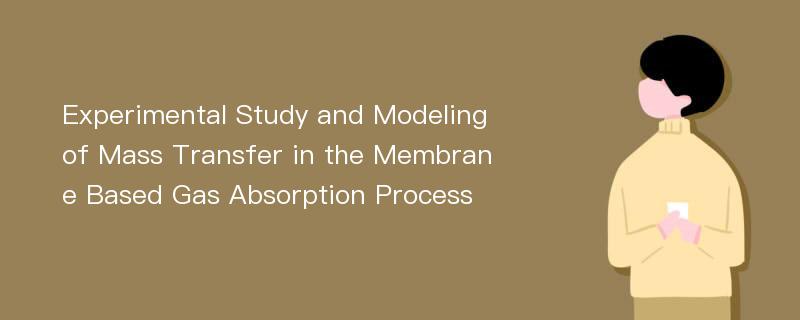
论文摘要
A study on membrane based absorption process has been done in order to better characterize mass transfer as a function of various parameters, such as membrane characteristic features, the shell side hydrodynamics conditions and the type of absorption taking place. The impact of these parameters on mass transfer has been experimentally investigated, analyzed, modeled and explained in this thesis.This is a two-part study. Part 1 deals with transient CO2 absorption using a flat sheet membrane module where the influence of membrane porosity on mass transfer has been presented. It further clarifies the seemingly conflicting viewpoints from other previous investigators as to whether the whole membrane area or the total area of the pores should be used for membrane based absorption mass transfer calculations. The results have indicated that depending on the rate of absorption process, whether physical or chemical, effective mass transfer area may not be the whole membrane area and nor the total area of the pores but somewhere in between.The second part explores the effect of shell side hydrodynamic conditions on steady-state mass transfer in a hollow fiber membrane. A mathematical model has rigorously been generated to predict the improved SO2 absorption performance due to an increased number of inlet channels into the shell side at various liquid velocities. In this model, a hollow fiber module has been treated as a cascade of numerous discrete stirred tank reactor(STR) cells. The model predictions reasonably agree with the experimentally determined mass transfer coefficients. Minor deviations have been attributed to complex combinedeffects of multi-inlet channels and the liquid flow velocity, which were no texplicitly incorporated into the model.Tracer experiments were also done to further validate the model. RTD curves became narrower and more symmetrically regular as the number of inlet channels increased. This also showed that flow maldistribution due to channeling, backmixing, and ’dead zones’ can further be eliminated at higher liquid flow velocity when the liquid stream is introduced into the shell side from three inlet channels.
论文目录
ABSTRACTCHAPTER 1:INTRODUCTION1.1 Membrane technology1.2 Mechanism of contacting phases1.3 Membrane contactors, a viable alternative1.4 Membrane separation compared to conventional contactors1.5 Advantages of membrane contactors1.6 Some drawbacks of membrane contactors1.7 Membrane gas absorption1.8 Mass transfer mechanism in membrane contactors1.9 Resistance to mass transfer1.10 Outline of this studyCHAPTER 2:Effects of Membrane Porosity on Membrane Absorption Process2.1 Problem statement2.2 Conflicting points of views2.3 Objective of this studyChapter 3:Theory3.1 Calculationofκ(ε)3.2 Calculation of φ(ε)CHAPTER 4:Experimental4.1 Membrane geometric parameters2 absorption experiment using ePTFE flat membrane'>4.2 Procedure for the unsteady state CO2 absorption experiment using ePTFE flat membraneCHAFFER 5:Results and discussion5.1 Experimental results5.1.1 Physical Absorption Using Pure Water5.1.2 Chemical Absorption Using 0.1 NaOH Aqueous solution5.2 The model analysis of the Experimental results5.2.1 The Actual membrane porosity is less than the efficacious porosity5.2.2 The Actual membrane porosity is almost equal to the efficacious porosity5.2.3 The actual membrane porosity is less than the efficacious porosity5.3.Simulation by model5.3.1 Calculation of the model parameter "T"5.3.2 The simulation results by the model5.3.3 Comparison of theoretical predictions with the experimental results5.4.ConclusionsCHAPTER 6:Mathematical model for mass transfer in a multi-inlet hollow fiber module6.1.Introduction6.2 Numerous shell side mass transfer correlations6.3 Phase flow configuration6.4 Shell side flow maldistribution6.5 Objective of the studyCHAPTER 7:Model Development7.1 Continuous stirred tank reactor2 Equilibrium Concentration in the liquid'>7.2 Gas-liquid interface and calculation of SO2 Equilibrium Concentration in the liquid7.3 Physical Absorption with Pure water7.4 Chemical Absorption using NaOH Aqueous SolutionCHAPTER 8:Experimental2 Absorption'>8.1 SO2Absorption8.2 Experimental Residence Time Distribution (RTD)CHAPTER 9:Results9.1 Experimental Results9.2.Calculated results9.3 RTD CurvesCHAPTER 10:Discussion and Conclusion10.1 Model results compared with experimental mass transfer10.2 Analysis of RTD Curves10.3 ConclusionReferencesAppendix A:List of FiguresAppendix B:List of TablesAcknowledgements
相关论文文献
Experimental Study and Modeling of Mass Transfer in the Membrane Based Gas Absorption Process
下载Doc文档
